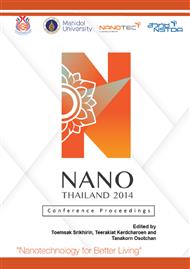p.157
p.165
p.169
p.175
p.182
p.186
p.193
p.198
p.203
Effect of Nanosilica on Mechanical and Thermal Properties of Cement Composites for Thermal Energy Storage Materials
Abstract:
This research article presents the mechanical and thermal properties of cement-based composite for thermal energy storage materials. The effects of nanosilica particle size and concentration determined by mixing nanosilica particle size of 50 nm, using nanosilica were of 1-5 wt%. Thermal properties coefficients were tested using a direct measuring instrument with surface probe (ISOMET2114). The influence of nanosilica on the performance, such as compressive strength, bulk density, thermal conductivity, volume heat capacity and thermal diffusivity of hardened composite cement pastes were studied for future solar thermal energy materials with better performance. According to the development of thermal storage materials and their application environment requirement in solar thermal power, the specimens were subjected to heat at 350, and 900°C. It were observed that, before heating, the compressive strength is optimized at nanosilica amount of 4wt% at the age of 28 days. Moreover, after heating at 350 oC and 900°C, the thermal conductivity and volume heat capacity of the cement paste enriched with nanosilica were significantly lesser than that of the before heating one.
Info:
Periodical:
Pages:
182-185
Citation:
Online since:
December 2015
Authors:
Price:
Сopyright:
© 2016 Trans Tech Publications Ltd. All Rights Reserved
Share:
Citation:


